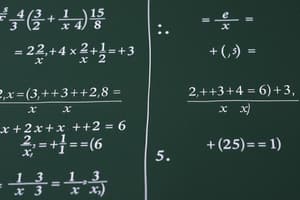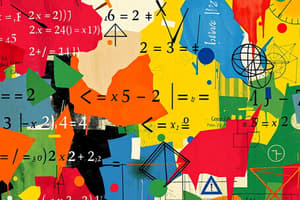Podcast
Questions and Answers
Which of the following describes a polynomial?
Which of the following describes a polynomial?
- An expression that involves sums of powers of variables (correct)
- An equation representing the relationship between two variables
- A function that only contains constants
- An expression involving the product of two variables
What is the primary purpose of inferential statistics?
What is the primary purpose of inferential statistics?
- To summarize and describe a dataset
- To calculate standard deviation and variance
- To make predictions about a population based on a sample (correct)
- To analyze each item within a sample
In the linear equation format y = mx + b, what does 'm' represent?
In the linear equation format y = mx + b, what does 'm' represent?
- The slope of the line (correct)
- The y-intercept
- The dependent variable
- The independent variable
Which of the following measures of central tendency is most affected by extreme values?
Which of the following measures of central tendency is most affected by extreme values?
What is an example of a quadratic equation?
What is an example of a quadratic equation?
What is a key characteristic of a normal distribution?
What is a key characteristic of a normal distribution?
Which of the following statements is true regarding inequalities?
Which of the following statements is true regarding inequalities?
What is the definition of a sample in statistics?
What is the definition of a sample in statistics?
What type of shape does a point represent in geometry?
What type of shape does a point represent in geometry?
Flashcards are hidden until you start studying
Study Notes
Algebra
- Definition: A branch of mathematics dealing with symbols and the rules for manipulating those symbols; it includes solving equations and understanding functions.
- Key Concepts:
- Variables: Symbols representing numbers (e.g., x, y).
- Expressions: Combinations of variables and constants (e.g., 3x + 2).
- Equations: Mathematical statements asserting equality (e.g., 2x + 3 = 7).
- Functions: Relationships between sets of data, typically expressed as f(x).
- Important Topics:
- Linear Equations: Equations of the form y = mx + b.
- Quadratic Equations: Equations of the form ax² + bx + c = 0, solved using factoring, completing the square, or the quadratic formula.
- Polynomials: Expressions that involve sums of powers of variables (e.g., x^3 - 4x + 7).
- Inequalities: Mathematical expressions that show the relationship between quantities that are not equal (e.g., x > 3).
Statistics
- Definition: The study of data collection, analysis, interpretation, presentation, and organization.
- Key Concepts:
- Population vs. Sample: Population is the entire group, while a sample is a subset used for analysis.
- Descriptive Statistics: Summarizes and describes the characteristics of a dataset (e.g., mean, median, mode, range).
- Inferential Statistics: Makes predictions or inferences about a population based on a sample (e.g., hypothesis testing, confidence intervals).
- Important Topics:
- Measures of Central Tendency: Mean (average), median (middle value), mode (most frequent value).
- Measures of Dispersion: Range, variance, standard deviation.
- Probability: The likelihood of an event occurring, often expressed as a fraction or percentage.
- Distributions: Normal distribution, binomial distribution, and others that describe how values are spread.
Geometry
- Definition: The branch of mathematics concerned with shapes, sizes, and the properties of space.
- Key Concepts:
- Points, Lines, and Angles: Fundamental elements of geometry.
- Shapes: Two-dimensional (2D) shapes such as triangles, circles, and quadrilaterals; three-dimensional (3D) shapes like cubes and spheres.
- Important Topics:
- Theorems: Pythagorean theorem (a² + b² = c² for right triangles), properties of parallel lines, congruence, and similarity.
- Area and Perimeter: Formulas to calculate the area and perimeter of various shapes (e.g., rectangle area = length × width).
- Volume and Surface Area: Formulas for calculating the volume and surface area of 3D shapes (e.g., cube volume = side³).
- Coordinate Geometry: Using algebraic methods to study geometric figures on the Cartesian plane.
Algebra
- Represents a branch of mathematics focused on symbols and rules for manipulating them, essential for solving equations and understanding functions.
- Variables are symbols used to denote unknown quantities, often represented by letters such as x and y.
- Expressions combine variables and constants, illustrating relationships (e.g., 3x + 2).
- Equations are mathematical statements indicating equality between two expressions (e.g., 2x + 3 = 7).
- Functions describe relationships between input and output, typically represented as f(x).
- Linear Equations follow the format y = mx + b, indicating a straight line on a graph.
- Quadratic Equations take the form ax² + bx + c = 0, commonly solved using factoring, completing the square, or quadratic formula methods.
- Polynomials involve sums of variables raised to whole number powers (e.g., x^3 - 4x + 7).
- Inequalities depict relationships where values are not equal, expressed using symbols (e.g., x > 3).
Statistics
- Focuses on data collection, analysis, interpretation, presentation, and organization.
- Differentiates between Population, which is the entire group being studied, and Sample, a subset that represents the population.
- Descriptive Statistics summarize data characteristics through metrics like mean, median, mode, and range.
- Inferential Statistics derive conclusions about populations from samples, involving techniques like hypothesis testing and constructing confidence intervals.
- Measures of Central Tendency include mean (average), median (middle value), and mode (most frequent value).
- Measures of Dispersion represent the variability in data, calculated as range, variance, and standard deviation.
- Probability assesses the chance of events occurring, often represented as fractions or percentages.
- Distributions describe how values are spread across populations, with common types including normal distribution and binomial distribution.
Geometry
- Encompasses the study of shapes, sizes, and properties of space in mathematics.
- Fundamental elements of geometry are Points, Lines, and Angles that form the basis of geometric study.
- Shapes can be categorized into two-dimensional (2D) figures like triangles, circles, and quadrilaterals, alongside three-dimensional (3D) forms such as cubes and spheres.
- The Pythagorean theorem, a² + b² = c², applies to right triangles, serving as a critical relationship in triangle measurements.
- Area and Perimeter can be calculated for various shapes, with specific formulas, such as the area of a rectangle being length × width.
- Volume and Surface Area calculations are essential for determining the space within and exterior of 3D shapes, with a cube's volume calculated as side³.
- Coordinate Geometry applies algebraic methods to analyze geometric figures within the Cartesian plane, enhancing the connection between algebra and geometry.
Studying That Suits You
Use AI to generate personalized quizzes and flashcards to suit your learning preferences.




